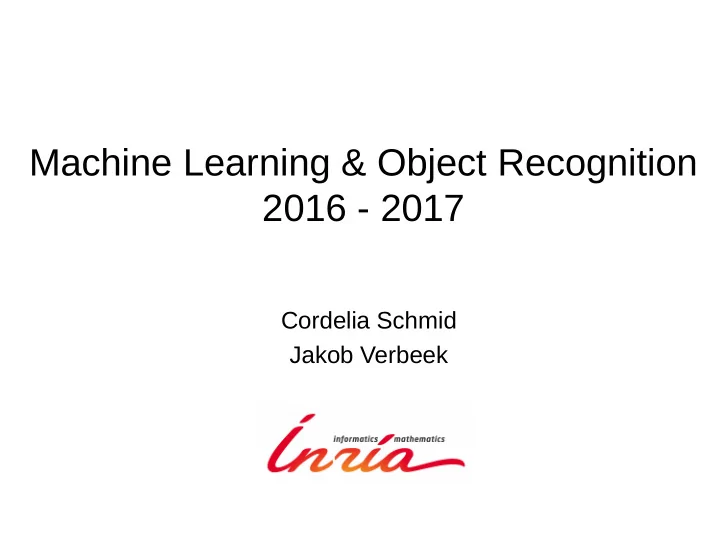

Machine Learning & Object Recognition 2016 - 2017 Cordelia Schmid Jakob Verbeek
Content of the course • Visual object recognition • Machine learning
Practical matters • Online course information – Schedule, slides, papers – http://thoth.inrialpes.fr/~verbeek/MLOR.16.17.php • Grading: Final grades are determined as follows – 50% written exam, – 25% paper presentation, – 25% quizes on the presented papers • Paper presentations: – each student presents once – each paper is presented by two students – presentations last for 15~20 minutes, time yours in advance!
Visual recognition - Objectives • Retrieval of particular objects and scenes • Accuracy and scalability to large databases …
Visual object recognition - Objectives • Detection of object categories – is there a … in this picture • More generally: relevance of labels (action, place, ...) person glass drinking indoors
Visual recognition - Objectives • Localization of object categories – where are the … in this image • Predict bounding boxes around category instances
Visual recognition - Objectives • Semantic segmentation of (object) categories – Which pixels correspond to …. • Possibly identifying different category instances
Visual recognition - Objectives • Human pose estimation • Self-occlusion and clutter
Visual recognition - Objectives • Human action recognition in video • Interaction of people and objects, temporal dynamics
Visual recognition - Objectives • Human action action localization in time, or space-time
Visual recognition - Objectives • Image captioning: Given an image produce a natural language sentence description of the image content
Difficulties: within object variations Variability : Camera position, Illumination,Internal parameters Within-object variations
Difficulties: within-class variations
Visual recognition pipeline • Low-level: Robust image description – Appropriate descriptors for objects and categories – Possibly unsupervised learning (PCA, clustering, ...) • High-level: Statistical modeling and machine learning – Map low-level descriptors to high-level interpretations – Capture the visual variability of specific objects or scenes, but more importantly at the category level • Today this distinction is less true – Learned low-level features – Training of low-level and high-level models unified – “Deep learning” framework
Robust image description • Scale and affine-invariant keypoint detectors • Robust keypoint descriptors
Robust image description • Matching despite significant viewpoint changes
Why machine learning? • Early approaches: simple features + handcrafted models • Can handle only few images, simple tasks L. G. Roberts, Machine Perception of Three Dimensional Solids, Ph.D. thesis, MIT Department of Electrical Engineering, 1963.
Why machine learning? • Early approaches: manual programming of rules • Tedious, limited and not directly data-driven Y. Ohta, T. Kanade, and T. Sakai, “ An Analysis System for Scenes Containing objects with Substructures,” International Joint Conference on Pattern Recognition , 1978.
Why machine learning? • Today: Lots of data, complex tasks • Instead of trying to encode rules directly, learn them from examples of inputs and desired outputs Internet images, Movies, news, sports personal photo albums
Why machine learning? • Today: Lots of data, complex tasks • Instead of trying to encode rules directly, learn them from examples of inputs and desired outputs Medical and scientific images Surveillance and security
Types of learning problems • Supervised – Classification – Regression • Unsupervised – Clustering – Generative models • Semi-supervised • Active learning • ….
Supervised learning • Given training examples of inputs and corresponding outputs, produce the “correct” outputs for new inputs • Two important classic cases: – Classification: outputs are discrete variables (category labels). Learn a decision boundary that separates one class from the other (separate images with and without cars in them) – Regression: also known as “curve fitting” or “function approximation.” Learn a continuous input-output mapping from examples (estimate the human pose parameters given an image)
Image captioning • Given an image produce a natural language sentence description of the image content • Also supervised learning, but with complex output space
Unsupervised Learning • Given only unlabeled data as input, learn some sort of structure from the data – Clusters – Low-dimensional subspace • The objective function is typically based on a ``reconstruction'': how well can the original data be explained by the recovered structure? • Most methods can be (re)formulated as a generative model: fit a model p(x) to ``predict'' data samples – Density estimation
Unsupervised Learning • Clustering: Discover groups of “similar” data points
Unsupervised Learning • Dimensionality reduction, manifold learning – Discover a lower-dimensional surface on which the data lives
Unsupervised Learning • Density estimation – Find a function that approximates the probability density of the data (i.e., value of the function is high for “typical” points and low for “atypical” points) – Can be used for anomaly detection
Other types of learning • Semi-supervised learning: lots of data is available, but only small portion is labeled (e.g. since labeling is expensive) – Why is learning from labeled and unlabeled data better than learning from labeled data alone? ?
Other types of learning • Active learning: the learning algorithm can choose its own training examples, or ask a “teacher” for an answer on selected inputs
Master Internships • Internships are available in the THOTH group • For research directions see http://thoth.inrialpes.fr • If you are interested send an email directly to team members that you are interested to work with
Recommend
More recommend